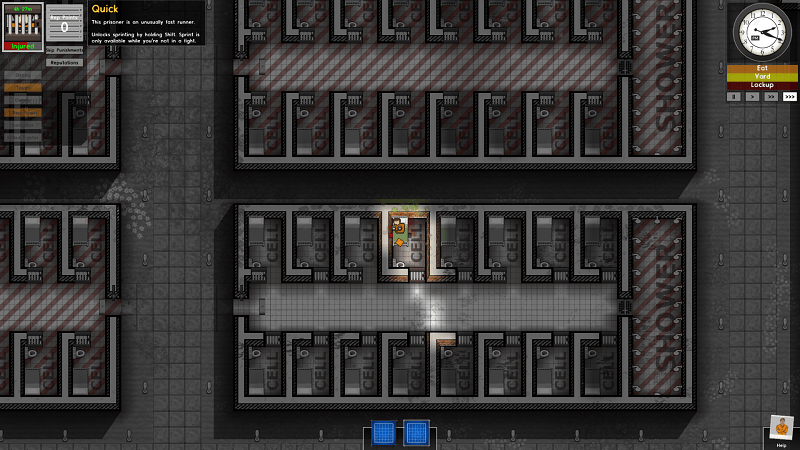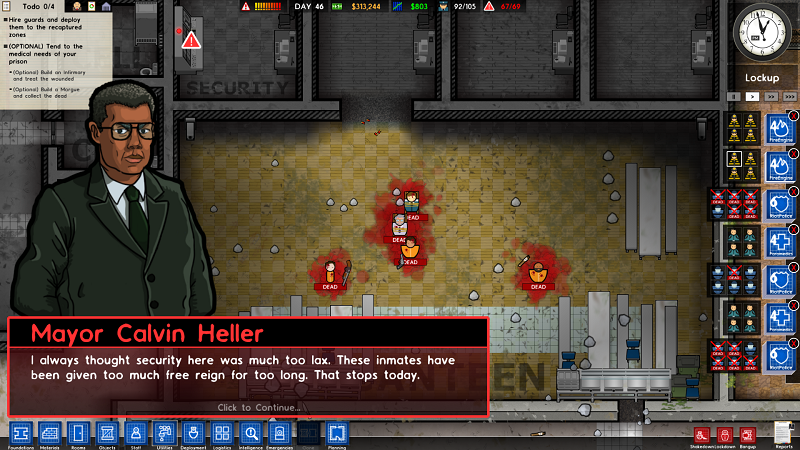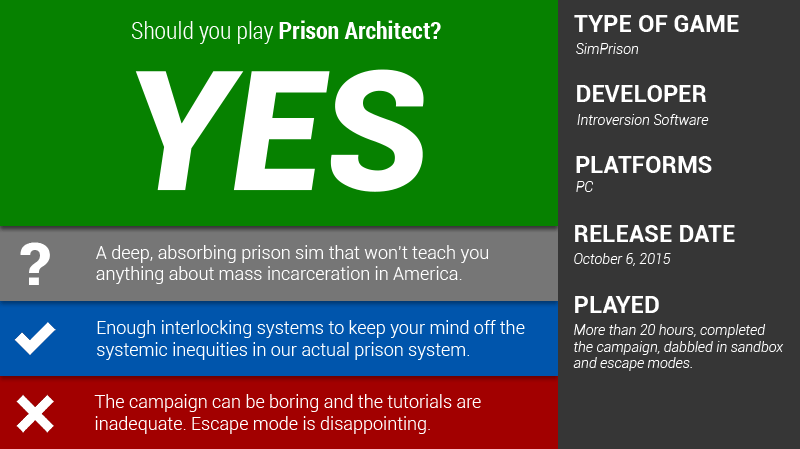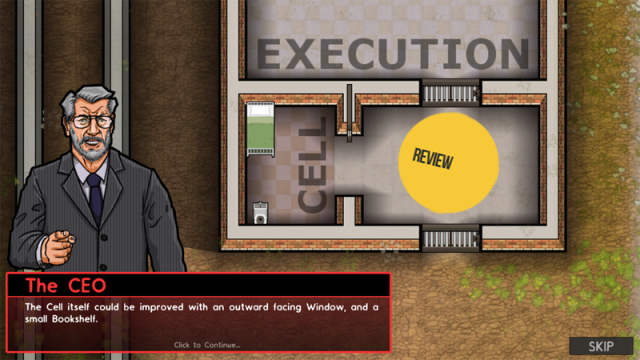Almost a decade ago in US politics, a majority of the Republicans in Congress voted to pass a prison reform bill called the Second Chance Act, and a Republican president signed it — during an election year, no less. As a policy matter, the bill was modest, less than $135 million a year for things like job training, mental health and substance abuse treatment, and housing assistance to try to reduce the re-arrest rate of people who leave prison.
As a symbolic political gesture, however, the passage of that law — and the Prison Rape Elimination Act that preceded it by a few years — was an earthquake. “For the first time in decades, Congress is poised to pass a bill that aims to make the lives of prisoners easier, not more difficult,” is how I put it when I wrote about the bill’s journey through the House of Representatives for the New York Times Magazine.
(Isn’t this a video game website? Why am I talking about US politics? I will get to Prison Architect. Bear with me.) More Democrats than Republicans voted for the Second Chance Act, but the leaders of the left-of-center party were quiet about the whole thing. Democrats were still terrified of the politics of prison reform and mass incarceration in the mid 2000s. Rahm Emanuel, soon to be one of the most powerful men in Washington, co-wrote a blueprint for Democratic success around the same time called The Plan. The lone paragraph that touched on the subjects of crime and prisons celebrated the get-tough, more-cops-on-the-streets achievements of President Bill Clinton.
The vocal support for prison reform in the early 2000s from Christian conservatives and President George W. Bush, who proposed a $408 million prisoner reentry program in his 2004 State of the Union address, helped to create the current political climate. Today, mass incarceration is regarded as a national crisis, and there is bipartisan support for reducing sentences and finding ways to put fewer people in prison. If you were politically sentient in 1988, when George H.W. Bush excoriated Michael Duakis for a furlough program in Massachusetts during the presidential campaign, it is almost unfathomable to now live in a country where the administration of an African American president has announced that it is going to release 6,000 inmates from federal prisons by the end of this month, and (thankfully) both parties shrug.

I guess my point is that, despite what you hear on cable TV or read on Twitter, politics is complicated, and mass incarceration is an especially thorny subreddit. Prison Architect, a PC sim about building and maintaining a correctional facility, cannot be separated from this extraordinary political moment and the thicket of class and race that brought us to it. Nor do the designers at the small British studio Introversion Software want the game to be judged outside of this context. As Mark Morris, an Introversion founder, said to the New Yorker last year, Prison Architect was not made “purely for the purposes of amusement.”
The game is, nonetheless, pretty diverting — especially once you get past the need to Google for help when you get stuck trying to figure out why your Alcoholics Anonymous group isn’t meeting in the new common room you built, or why your newly hired dog handlers aren’t taking the prison canines out on patrol. Prison Architect gestated in Steam’s Early Access program for two years and so has been playable and subject to critiquefor as long. The game exited open development last week with its 1.0 edition, the first finished version. One of the benefits of Prison Architect‘s long Early Access development is that most — although not all — of the things that I struggled to grasp in the game’s opening hours have been asked and answered on the game’s official wiki or its Steam forum.
When those hiccups subside, Prison Architect becomes a deep and absorbing sim, a deserving heir to the games made by the now-shuttered Maxis studio that Will Wright helped to found. I put more than 20 hours into the game this week, and I’m still uncovering new systems to play with, learning how to use new surveillance technologies, and experimenting with different riot-control tactics.

The tutorial unfolds during an overlong campaign mode that is much duller than the sandbox at the exit. In both modes, the player is cast as an executive at a for-profit prison corporation. Even so, it is only the prisoners who are given names, ages, and desires. The guards and the rest of the prison staff are ciphers. You are tasked with meeting the needs of your inmates, not your employees or shareholders.
During the campaign the law-and-order mayor urges you to take a punitive approach with your inmates, while others stress the importance of work, education, and rehabilitation. In addition to the obviously necessary cell blocks, you can build chapels, workshops, kitchens, classrooms, and more. You can — and will need to — hire doctors, psychologists, a construction foreman, a lawyer. Legal, I should note, is there to help you find creative ways to evade laws and regulations (one of the very few times the game suggests that there is a political backdrop for all this work), rather than assisting the general population.
No matter how devoted you are to the physical, mental, and spiritual needs of your prisoners, some of them are going to get violent. There are multiple levels of guards — including armed ones with itchy trigger fingers — to hire to help keep the inmates docile. Eventually you unlock body armour and tasers.

The game lets you reverse the stakes in its Escape Mode, new this month, which lets you download prisons made by other players and be admitted as a new offender. You build your reputation by getting in fights, and then you use your reputation points to improve your combat skills and acquire gang members. Soon enough, you’re stealing screwdrivers and drills from the workshop, brawling in the canteen during lunch, and digging a tunnel that begins beneath the toilet in your cell.
Described that way, Escape Mode sounds more thrilling than it is. After an hour or so with it, I wanted to go back to the sandbox. The joys of Prison Architect, as with any good sim, are those of making a plan, executing it, and then managing the decay when things go awry. Should you apply for a federal grant to run a nutrition experiment on your inmates to make some quick cash, or do you invest in some maximum-security equipment and training for a bigger payday? The learning curve is steep, and the campaign is too often a slog, but the reward is the best kind of toy: flexible and open to player interpretation but grounded in a very specific fiction.
Still, after a dozen or so hours, the significance of the setting begins to recede. As Paolo Pedercini wrote of the game’s alpha version in Kotaku last year, “Players are so busy micromanaging and streamlining the internal flows of bodies and objects that they may as well forget they are running a prison.” I found myself wanting to watch my prison grow just for the sake of growth. The individual needs of each inmate grew less pressing. Their docility, in aggregate, however it was purchased, would give me the time and freedom to pursue my aims.
Maybe that’s the point of Prison Architect, to ease the player into complicity with bureaucratic evil. Is it churlish to want more? The system in Prison Architect is well-designed, but it is also strikingly self-contained, free of many of the constraints imposed on real prison administrators and employees in the United States. The game does not even attempt to model, systemically, the effects of political pressure from voters on the treatment of prisoners.

To cite one example, as Ta-Nehisi Coates noted in his recent Atlantic cover story on mass incarceration, South Carolina’s lawmakers in the 1990s “cut back on in-prison education, barred air conditioners, jettisoned televisions, and discontinued intramural sports.” Imagine a Prison Architect that used an “events system” to simulate the ebb and flow of tough-on-crime policies on your inmates. Or one that tried to demonstrate the effects of our broken plea bargain system. Or that grappled with the evidence on the relationship between incarceration and the crime rate. Or that made visible the stark racial disparities in the American prison population. Video games would seem to be well suited to at least hazard an attempt at simulating the complexity of our politics, of showing how well-meaning people can make small decisions that seem right to them but that add up to a monstrous injustice.
Prison Architect won’t teach you anything about mass incarceration in the United States anymore than Oregon Trail will teach you how to settle the 19th-century frontier without succumbing to dysentery. You can build a really cool prison in it, though.
Chris Suellentrop is the critic at large for Kotaku and a host of the podcast Shall We Play a Game?

Comments
4 responses to “Prison Architect: The Kotaku Review”
Been playing this on and off through the development process. It’s an excellent game that’s easy to sink hours at a time in without realising, and next thing you know it’s 3 in the morning.
…two days after you sat down.
And it’s out on Mac. This makes me happy.
Can I just add that while it is interesting to see the comparisons of PA to real life prisons and politics, I am pretty sure there was more on American Prisons then the actual game. Bit odd considering the developers themselves have labeled the game as “not any one country” in regard to Prison and death penalty laws.
I feel the whole american history recap wasn’t needed..